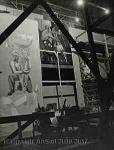Anton Refregier
Anton Refregier
Born: 1905
Death: 1979
Biography:
Anton Refregier a painter and muralist active in Works Progress Administration Federal Art Project commissions, and in teaching art. He was a Russian immigrant to the United States.
He is known, among other works, for his mural "The History of California" located in the Rincon Center, in downtown San Francisco, California. It depicts the state's history across twenty seven panels that he painted from 1940 to 1948.
Refregier was born in Moscow and emigrated to the United States in 1920. After working various odd jobs in New York City, he earned a scholarship to the Rhode Island School of Design in 1921. After finishing school, Refregier moved back to New York in 1925. To earn a living, Refregier worked for interior decorators, creating replicas of François Boucher and Jean-Honoré Fragonard paintings. He continued his creative development, and traveled to Munich in 1927. While there he studied under painter Hans Hofmann, who was creating abstract expressionism paintings.
Refregier returned to New York state during the late 1920s, and lived in the Mount Airy artists' colony in Croton-on-Hudson. In an interview, Refregier referred to this time as the most wonderful period of his life, although it was a peculiar kind of wonderful. He was referring to the effects of the Great Depression in the 1930s. Refregier learned 'a lot about life' during these times, and also learned more about the United States economy and government.
Refregier found inspiration in the tragic events. He was quoted as saying that "the richer we in possessions, the poorer we became in their enjoyment." He said the amazing part of that period was the "human quality, the humanist attitude that [everyone] had" and the discovery that "the artist was not apart from the people."
He struggled as a muralist until the federal government began the Federal Art Project in 1935, within the Works Progress Administration—WPA (renamed in 1939 the "Works Projects Administration"), that created sponsorship of artists. When asked about the program Refregier said that it was "by the wisdom of one of the greatest Presidents we ever had, Roosevelt, it's common knowledge the WPA, a relief program, was established [because] it was necessary to protect the skills of the American people." Refregier received $23.86 a week on the FAP—WPA rolls.
Refregier was a faculty member and Chairman of the Board at the American Artists School from 1937—1938. Refregier began to gain notoriety in his field, and so was given the opportunity to choose between two assignments for his first WPA—Federal Art Project. He was given the choice of painting a mural in a courthouse, or in the children's ward of a hospital. Refregier chose the latter, because did not want the pressure inherent in designing public artwork for a courthouse. He was assigned to the children's ward mural project at Green Point Hospital, in Brooklyn. The project took a little over a year to complete, and involved five other contributing artists.
After completing the hospital mural, Refregier's work became primarily government-sponsored projects. These included the World's Fair Federal Works Buildings in the 1933 Chicago World's Fair and the Section of Fine Arts of the Public Building Administration in the Treasury Department. He also worked as a teacher, supervising artist, and a mural supervisor. He collaborated with other contemporary artists, such as Byron Randall.
Anton Refregier won many mural competitions, and started to gain national renown as a muralist.
In 1940 he won the commission for his most famous work, the "History of San Francisco", located in the Rincon Center in San Francisco, California. He competed with a number of other artists for the commission, including artist Richard Haines, first funded as a project of the Section of Painting and Sculpture. The mural is formally known as the "History of San Francisco" and is located in the lobby of Rincon Center, a building that once served as a United States post office and was known then as Rincon Annex. Refregier painted the mural with casein tempera on white gesso over plaster walls, in the social realism style. Work restarted after the war, in 1946, and took two years to complete at a cost of $26,000.
The mural consisted of 27 panels and covered 400 square feet (37 m2) of wall space. The mural panels depicted various historical events from California's past. It included the 1877 anti-Chinese Sand Lot riots, the 1934 San Francisco Waterfront Strike, and the Trial of trade unionist Tom Mooney, that was based on fabricated evidence. Refregier used these tragedies as inspiration. Refregier "believed that art must address itself to contemporary issues and that a mural painting in particular must not be 'banal, decorative embellishment,' but a 'meaningful, significant, powerful plastic statement based on the history and lives of the people.'"
The mural also depicted: the California Gold Rush; the 1860s building by Union Pacific of the western First Transcontinental Railroad; the disastrous 1906 San Francisco earthquake and fire; and further into the twentieth century with the city's Second World War contributions, and culminating in the 1945 signing of the United Nations Charter in the San Francisco War Memorial Opera House. Some were suspicious of Refregier as a communist because of his Russian—USSR background, and his mural topics about social issues. None of this bothered Refregier, he was only concerned about his art.
More...
Wikipedia link: Click Here














